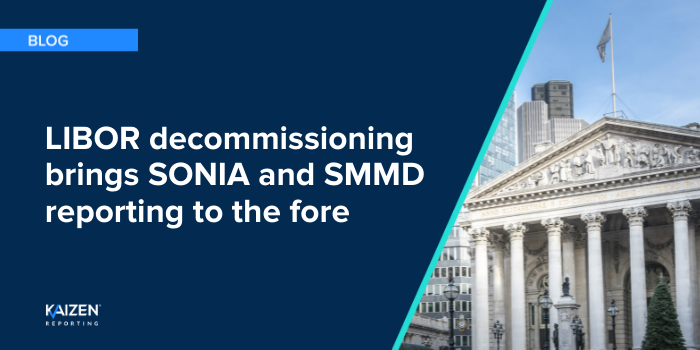LIBOR decommissioning brings SONIA and SMMD reporting to the fore

The death knell for GBP LIBOR began to sound back in March this year with the FCA’s announcement that most of the LIBOR tenors will cease to operate by 31 December 2021. LIBOR’s legacy dating back to 1980s was deeply tarnished and irreparably damaged by the LIBOR scandal of the 2000s.
SONIA and Sterling Money Market Daily reporting
GBP LIBOR is being replaced by the Sterling Overnight Index Average (SONIA). SONIA is a new regulatory report-driven unsecured benchmark rate for Sterling Money Markets. Sterling Money Market Daily (SMMD) reporting is the dataset used by the Bank of England (BoE) in order to calculate the daily publication of SONIA benchmark interest rates. This reporting also plays a vital role in the BoE’s monetary and financial policy decision making. SMMD reporting aids the BoE in monitoring the economic impact of monetary policy, setting interest rates, market financing and money market surveillance. It provides much needed transparency on short-term wholesale borrowing and lending activities within the Sterling area.
Accurate reporting is expected by regulators
LIBOR reporting became a painful episode for a number of UK financial institutions, with firms and traders finding themselves in the courts. As a consequence the controls around SMMD reporting are stringent and the penalties for getting it wrong are dissuasive. The mandatory control requirements for SMMD reporting institutions are framed by the Bank of England Money Markets Code and the FCA’s Senior Managers and Certification Regime (SMCR).
What are the reporting requirements?
- Periodic and comprehensive testing of the reporting firm’s data, including reference data
- Early detection of failures and gaps in reporting flows
- Controls to ensure both secured and unsecured borrowing and lending activities are captured
- Governance arrangements to ensure compliance with industry standards and market best practice with a minimum of annual attestation by both a senior compliance officer and a relevant business area representative.
“Each reporting institution’s internal controls for SMMD Reporting should include comprehensive testing of automated processes and documented change control processes, procedures to detect failure to capture a segment of eligible transactions and failure to exclude non-eligible transactions.”
– Bank of England, SMMD Reporting Instructions Version 4.6, December 2020
The global view
The UK is not alone in phasing out the LIBOR benchmark. The Euro area is also resorting to new regulatory report-driven overnight unsecured benchmark interest rates. The Euro Short-Term rate (€STR) has been published since October 2019, driven by transactions reported under the Money Markets Statistical Reporting (MMSR) regulation. €STR will be officially adopted on 3 January 2022 as the replacement of Euro money markets benchmark superseding the Euro Overnight Index Average (EONIA) and the Euro Interbank Offered Rate (EURIBOR). Indeed, across the globe new alternative interest rates are replacing LIBOR such as the Office of Financial Research report based Secured Overnight Financing Rate (SOFR) in the US, and the Tokyo Overnight Average Rate (TONA) in Japan.
The right controls
What controls does your firm have in place for SMMD and MMSR reporting? Are you satisfied that your firm meets the requirements listed above? Kaizen can provide quality assurance through regulatory testing of these regimes though our multi-award winning ReportShield™ services, giving you confidence that you are meeting your regulatory obligations.
- For a conversation with Faizal or one of our regulatory specialists about putting the right controls in place for SMMD or MMSR reporting, please contact us.


